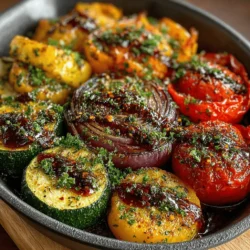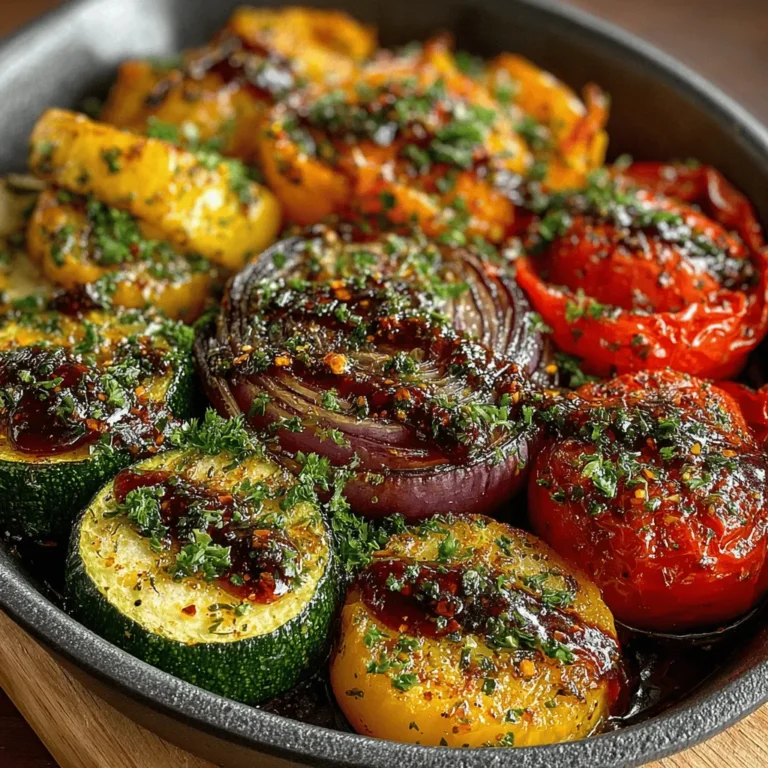Introduction
In a world increasingly focused on health-conscious eating, Baked Balsamic Bliss stands out as a vibrant and versatile dish that can elevate your culinary repertoire. This recipe transforms simple vegetables into a gourmet side dish, bursting with flavor and nutrients, making it a perfect addition to any meal. The star of this dish, balsamic vinegar, has gained popularity among home cooks and professional chefs alike for its rich complexity and ability to enhance a wide variety of ingredients.
Balsamic vinegar, with its sweet and tangy flavor, not only brings an exceptional taste to the table but also offers numerous health benefits. Rich in antioxidants and known for its potential to regulate blood sugar levels, balsamic vinegar is a staple in modern kitchens. When paired with an array of fresh vegetables, it creates a delightful explosion of flavors that can impress both novice and experienced cooks. The ease of preparation makes Baked Balsamic Bliss accessible to everyone, allowing you to enjoy a gourmet experience without the hassle.
In this article, we will explore the ingredients that make up this delicious dish and guide you through the preparation steps to ensure your Baked Balsamic Bliss turns out perfectly every time.
Understanding the Ingredients
Balsamic Vinegar
Balsamic vinegar has its origins in Modena, Italy, where it has been produced for centuries. Traditional balsamic vinegar is made from the must of freshly crushed grapes, which is then aged in wooden barrels for several years, allowing it to develop its complex flavors. The aging process contributes to its unique sweetness and acidity, making it a favorite for dressings, marinades, and glazes. In our Baked Balsamic Bliss recipe, balsamic vinegar serves as the primary flavoring agent, coating the vegetables in a luscious glaze that caramelizes beautifully during baking.
Olive Oil
The quality of olive oil can significantly impact the flavor and health benefits of your dish. Extra virgin olive oil, in particular, is packed with monounsaturated fats and antioxidants, making it a heart-healthy choice. In Baked Balsamic Bliss, olive oil not only helps to enhance the overall flavor but also contributes a smooth texture that allows the marinade to cling to the vegetables. When selecting olive oil for this recipe, opt for a high-quality brand with a robust flavor profile that complements the tangy balsamic vinegar.
Honey
Incorporating honey into the marinade serves a dual purpose: it balances the acidity of the balsamic vinegar while adding a touch of natural sweetness. Honey is also known for its antioxidant properties and can provide a boost of energy. The sweetness of honey complements the earthy flavors of the vegetables, creating a harmonious blend that elevates the entire dish. When using honey, consider opting for a raw or local variety to enhance the flavor and nutritional benefits.
Dijon Mustard
Dijon mustard is not just a condiment; it’s a flavor powerhouse that brings depth and complexity to the marinade. Its sharpness cuts through the sweetness of the honey and the acidity of the balsamic vinegar, creating a well-rounded flavor profile. Additionally, the emulsifying properties of Dijon mustard help to bind the ingredients together, ensuring a consistent and flavorful coating for the vegetables.
Herbs and Spices
The addition of fresh herbs and spices is what truly elevates Baked Balsamic Bliss to a gourmet experience. Fresh rosemary and thyme provide aromatic notes that enhance the overall flavor, while garlic adds a savory depth that complements the sweetness of the balsamic glaze. A pinch of salt and freshly cracked black pepper is essential for seasoning, while red pepper flakes can add a touch of heat for those who enjoy a little spice. Each herb and spice contributes to the dish’s aroma and taste, making every bite a delightful experience.
Preparation Steps
Preheating the Oven
Before diving into the preparation of your Baked Balsamic Bliss, it is crucial to preheat your oven to ensure optimal cooking results. Preheating allows for even cooking and helps achieve that desirable caramelization on the vegetables, enhancing their natural sweetness. Set your oven to 400°F (200°C) and give it ample time to reach the desired temperature before placing your baking dish inside.
Mixing the Marinade
Creating the marinade is a straightforward process, but achieving the perfect balance of flavors requires careful attention to proportions. In a medium-sized bowl, combine balsamic vinegar, olive oil, honey, and Dijon mustard. Whisk the ingredients together until well blended, ensuring that the honey is fully incorporated. This step is essential as it creates a cohesive marinade that will infuse each vegetable with flavor. Taste the marinade and adjust the sweetness or acidity to your preference, adding more honey or balsamic vinegar as desired.
Preparing the Baking Dish
When it comes to preparing your baking dish for Baked Balsamic Bliss, there are a few options to consider. For easy cleanup, line your baking dish with parchment paper, which will help prevent sticking and make it easier to transfer the finished dish to a serving plate. Alternatively, you can lightly grease the dish with olive oil to ensure the vegetables cook evenly and do not adhere to the surface.
Selecting and Preparing Vegetables
The success of Baked Balsamic Bliss lies in the selection of vegetables. While the recipe is versatile and allows for a variety of options, certain vegetables work particularly well due to their textures and flavors. Consider using a combination of bell peppers, zucchini, eggplant, red onions, and cherry tomatoes for a colorful and delicious medley.
When selecting vegetables, opt for fresh, seasonal produce for the best flavor. Look for vibrant colors and firm textures, avoiding any signs of wilting or spoilage. Once you have chosen your vegetables, wash them thoroughly and prepare them for baking. Cut them into uniform pieces, ensuring they are roughly the same size for even cooking. For example, slice bell peppers into strips, chop zucchini into rounds, and cube eggplant into bite-sized pieces.
By taking the time to select and prepare high-quality vegetables, you set the stage for a truly delightful Baked Balsamic Bliss. The combination of fresh ingredients and a flavorful marinade will create a dish that is not only visually appealing but also packed with nutrients. Now that you have a solid understanding of the ingredients and preparation steps, you’re ready to embark on your culinary journey to create this delicious vegetable delight.
Baked Balsamic Bliss is an irresistible dish that combines the sweet tang of balsamic vinegar with a colorful array of vegetables, creating a mouthwatering side that enhances any meal. In this section, we’ll explore the best vegetables to use, cutting techniques for perfect presentation, baking processes, serving suggestions, and the nutritional benefits of this delightful dish.
Best Vegetables for Baked Balsamic Bliss
Choosing the right vegetables is crucial for achieving the optimal flavor and texture in Baked Balsamic Bliss. Here are some of the best vegetables to consider:
– Bell Peppers: Their sweet and slightly tangy flavor complements the balsamic vinegar beautifully. Use a mix of colors for visual appeal.
– Zucchini: Soft and tender when baked, zucchini absorbs the balsamic flavors, becoming flavorful and succulent.
– Cherry Tomatoes: These burst with sweetness as they roast, adding juiciness to the dish.
– Red Onions: Their sharpness mellows during baking, contributing a subtle sweetness that enhances the overall flavor.
– Mushrooms: Their umami richness pairs well with balsamic vinegar, providing a depth of flavor.
– Carrots: Their natural sweetness caramelizes when baked, balancing the acidity of the balsamic vinegar.
Feel free to experiment with other vegetables such as asparagus, eggplant, or broccoli. The key is to balance flavors and textures for a satisfying dish.
Cutting Techniques
The way you cut your vegetables can significantly affect both cooking time and presentation. Here are some tips to ensure even cooking and an appealing appearance:
– Uniform Size: Cut all vegetables into similar sizes to ensure they cook evenly. For example, dice bell peppers and zucchini into 1-inch cubes, slice red onions into wedges, and halve cherry tomatoes.
– Thickness Matters: Keep in mind that denser vegetables like carrots may need to be cut thinner than softer ones like zucchini to achieve uniform cooking. Aim for a thickness of about 1/4 to 1/2 inch for even roasting.
– Presentation: Consider how the vegetables will look once baked. For added visual interest, alternate colors and shapes. You might arrange zucchini rounds, bell pepper strips, and tomato halves in a visually appealing pattern.
Baking Process
Baking is where the magic happens in Baked Balsamic Bliss. Here’s a detailed breakdown of the process to ensure your vegetables turn out perfectly.
Baking Temperature and Time
For optimal caramelization and flavor development, preheat your oven to 425°F (220°C). This temperature is ideal for roasting vegetables, allowing them to brown and caramelize without becoming mushy. Bake the vegetables for 25 to 30 minutes. The high heat promotes the Maillard reaction, enhancing the dish’s overall flavor profile.
Stirring for Even Cooking
To achieve uniform cooking and flavor distribution, stir the vegetables halfway through the baking process. This ensures that all sides of the vegetables come into contact with the hot baking sheet, promoting even browning. Use a spatula to gently toss the vegetables, taking care not to break them apart. Return them to the oven for the remaining baking time.
Serving Suggestions
The versatility of Baked Balsamic Bliss makes it an excellent addition to any meal. Here are several creative ways to enjoy this dish:
As a Side Dish
Baked Balsamic Bliss pairs beautifully with a variety of main courses. Serve it alongside grilled chicken, pan-seared salmon, or a hearty grain bowl. The sweet and tangy flavors will complement meats and add a vibrant touch to your plate.
As a Salad Topping
Elevate your salads by adding a generous scoop of Baked Balsamic Bliss. Toss it on top of mixed greens, quinoa, or couscous for a nutritious boost. The roasted vegetables bring flavor and texture, turning a simple salad into a satisfying meal. Drizzle with extra balsamic reduction for an added touch.
Storing and Reheating
If you have leftovers, Baked Balsamic Bliss can be stored in an airtight container in the refrigerator for up to 3 days. When reheating, do so in the oven at a low temperature (around 350°F or 175°C) for about 10-15 minutes, or until warmed through. This method preserves the texture and flavor of the vegetables better than a microwave, which can make them soggy.
Nutritional Benefits
Baked Balsamic Bliss is not only delicious but also packed with nutritional benefits that make it a guilt-free option for any meal.
Low-Calorie and Nutrient-Dense
This dish is inherently low in calories, thanks to the variety of non-starchy vegetables. Each serving is rich in vitamins, minerals, and fiber, making it a filling yet light choice for health-conscious eaters. The addition of healthy fats from olive oil enhances absorption of fat-soluble vitamins, providing a well-rounded dish.
Rich in Antioxidants
Balsamic vinegar, a key ingredient in this recipe, is known for its antioxidant properties. It contains compounds like polyphenols, which help combat oxidative stress in the body. Additionally, the colorful array of vegetables contributes an abundance of vitamins and antioxidants, supporting overall health.
Conclusion
Baked Balsamic Bliss is a simple yet delightful dish that showcases the wonderful flavors of roasted vegetables enhanced by balsamic vinegar. As we’ve explored, the choice of vegetables, cutting techniques, and baking methods play crucial roles in achieving the perfect outcome. This dish’s versatility makes it suitable for various occasions, whether as a nourishing side dish, a vibrant salad topping, or a meal prep favorite.
Encourage your culinary creativity by experimenting with different vegetables and variations of the recipe. With its appealing presentation and health benefits, Baked Balsamic Bliss is sure to become a staple in your kitchen, easily adapting to both warm and cold presentations. Enjoy this flavorful medley as part of your meal plan and savor every bite!



